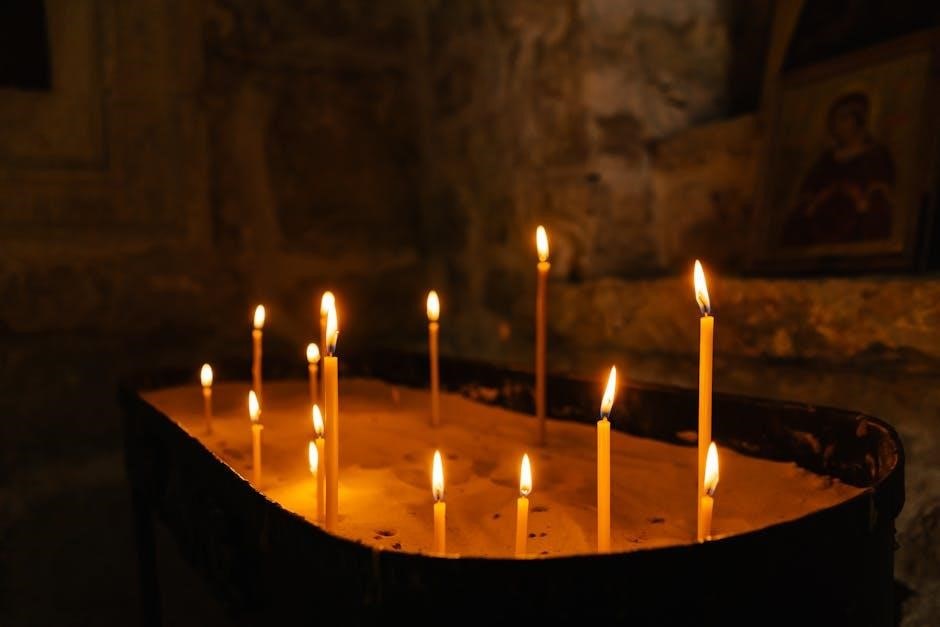
Article Plan: The Bloody Chamber PDF
This article will delve into Angela Carter’s “The Bloody Chamber,” exploring its gothic style and fairy tale re-imaginings. It will analyze themes of darkness, male aggression, and feminist interpretations. The availability of the text in PDF format will also be addressed.
Angela Carter’s “The Bloody Chamber,” a collection of darkly reimagined fairy tales, stands as a cornerstone of feminist gothic literature. Published in 1979, this anthology delves into the unsettling depths of familiar narratives, subverting traditional tropes and exploring themes of sexuality, power, and violence. Carter’s unique approach breathes new life into classic stories, infusing them with a provocative and often disturbing sensibility.
The collection is inspired by Charles Perrault’s fairy tales, Carter transforms these narratives into explorations of female agency and societal constraints. Through vivid imagery and a keen understanding of the gothic tradition, Carter crafts a world where beauty can turn into a beast, and innocence is constantly threatened.
The stories are not merely retellings but rather deconstructions, challenging patriarchal norms and giving voice to the silenced heroines of folklore. “The Bloody Chamber” is a literary exploration, inviting readers to confront the darkness hidden within seemingly innocent tales.
Angela Carter’s Gothic Style
Angela Carter’s gothic style in “The Bloody Chamber” is characterized by its blend of romantic trappings and unsettling themes. She masterfully employs elements of darkness, concealment, and the grotesque to create an atmosphere of terror and unease. The stories are steeped in vivid imagery, often focusing on decaying settings, opulent but sinister interiors, and the psychological states of her characters.
Carter uses the gothic tradition to explore the hidden aspects of human nature, particularly the darker sides of sexuality and power dynamics. Her writing challenges conventional notions of beauty and horror, often blurring the lines between the two. By incorporating elements of the supernatural and the macabre, she creates a world where the familiar becomes strange and the boundaries between reality and nightmare dissolve.
Her gothic sensibility is also evident in her use of symbolism and allegory, layering her narratives with deeper meanings and interpretations. This combination of lush prose and disturbing content makes Carter’s gothic style uniquely compelling and thought-provoking.
Fairy Tale Re-imaginings
Angela Carter’s “The Bloody Chamber” is renowned for its innovative re-imaginings of classic fairy tales. Instead of simply retelling familiar stories, Carter deconstructs and subverts them, imbuing them with new layers of meaning and challenging traditional interpretations. She draws inspiration from Charles Perrault and other sources, transforming innocent narratives into complex explorations of sexuality, power, and identity.
Carter’s re-imaginings often involve a deliberate disruption of the original fairy tale’s moral framework. She introduces elements of ambiguity and moral complexity, forcing readers to question the conventional roles of heroes and villains. By exploring the darker aspects of human nature, she exposes the underlying anxieties and desires that fairy tales often conceal.
Her stories feature empowered female characters who challenge patriarchal structures and reclaim their agency. Through these reinterpretations, Carter uses fairy tales as a vehicle for feminist critique, offering a fresh and provocative perspective on timeless narratives. This makes “The Bloody Chamber” a significant contribution to contemporary literature.
“Bluebeard” and “The Bloody Chamber”
The title story of Angela Carter’s collection, “The Bloody Chamber,” is a direct and compelling reimagining of the classic “Bluebeard” fairy tale. Carter’s version retains the core elements of the original story: a wealthy, enigmatic man with a dark secret, a naive young bride, and a forbidden chamber that holds the evidence of his past crimes. However, Carter infuses the narrative with her distinctive gothic style and feminist perspective.
The story explicitly references the “Bluebeard” narrative through characters, settings, and plot devices. The Marquis, Carter’s version of Bluebeard, embodies the archetype of the wealthy, older man with a mysterious past. The chamber itself serves as a physical manifestation of his sinister secrets and the violence he has inflicted on previous wives.
Carter’s reimagining delves deeper into the psychological complexities of the characters, particularly the young bride. Her transformation from an innocent girl to a self-aware woman is central to the story’s thematic concerns. By exploring the dynamics of power, desire, and transgression, Carter offers a provocative reinterpretation of the “Bluebeard” myth.
Darkness and Concealment in the Chamber

In Angela Carter’s “The Bloody Chamber,” darkness and concealment are central motifs that contribute significantly to the story’s eerie atmosphere and thematic depth. The chamber itself is shrouded in darkness, symbolizing the hidden secrets and sinister nature of the Marquis. This darkness serves to conceal the horrors within, both literally and figuratively.

The use of darkness emphasizes the unknown and the unspoken. It mirrors the bride’s naiveté and her initial lack of awareness regarding the Marquis’s true nature. As she ventures deeper into the chamber, the darkness becomes more oppressive, mirroring her growing realization of the horrors that lie hidden within.
The concealed nature of the chamber reflects the hidden aspects of male dominance and the secrets that perpetuate patriarchal power. The Marquis’s past transgressions are concealed within the chamber, representing the historical silencing and subjugation of women. The darkness, therefore, becomes a metaphor for the suppression of truth and the concealment of violence.
Moreover, the darkness heightens the sense of unease and terror, creating an atmosphere of suspense and anticipation. It amplifies the psychological impact of the discoveries made within the chamber, leaving a lasting impression on both the protagonist and the reader.

Horrors Within the Chamber
The heart of Angela Carter’s “The Bloody Chamber” lies in the unspeakable horrors concealed within its walls. This chamber is not merely a physical space but a repository of trauma, violence, and the dark underbelly of patriarchal power. The horrors it contains are both literal and symbolic, representing the accumulated suffering of women who have fallen victim to male aggression.
Within the chamber, the protagonist discovers evidence of the Marquis’s past crimes: the preserved bodies of his former wives, each a testament to his cruelty and dominance. These gruesome remains serve as a stark reminder of the dangers lurking beneath the surface of aristocratic charm and wealth. The chamber becomes a macabre museum, showcasing the consequences of unchecked male power and the objectification of women.
The horrors also extend beyond the physical realm, encompassing psychological and emotional trauma. The protagonist’s growing awareness of the Marquis’s true nature and the fate of his previous wives leads to a profound sense of dread and vulnerability. The chamber becomes a symbol of her own potential demise, forcing her to confront the terrifying reality of her situation.

Ultimately, the horrors within the chamber serve as a catalyst for the protagonist’s transformation. They compel her to confront her own passivity and to find the strength to resist the forces of oppression.
Male Aggression and Sexuality
In “The Bloody Chamber,” Angela Carter explores the complex and often disturbing relationship between male aggression and sexuality. The Marquis, the story’s central male figure, embodies a predatory form of masculinity that is both alluring and terrifying. His wealth, power, and aristocratic status grant him a sense of entitlement, which he uses to exploit and control women.
The Marquis’s sexuality is inextricably linked to his aggression. He views women as objects of desire and possession, seeking to dominate and control them through physical and psychological manipulation. His fascination with pornography and his collection of torture devices further underscore the connection between his sexual desires and his violent tendencies.
Carter challenges traditional romantic notions of love and marriage, exposing the power dynamics that often underlie these relationships. The Marquis’s courtship of the young protagonist is characterized by a calculated display of wealth and charm, which masks his true intentions. He seeks to transform her into a passive object of his desire, stripping her of her agency and individuality.
Through the character of the Marquis, Carter critiques the societal norms that enable male aggression and perpetuate the objectification of women. She exposes the dangers of unchecked male power and the devastating consequences it can have on individual lives. The story serves as a cautionary tale, urging readers to question and challenge the prevailing attitudes towards gender and sexuality.
Feminist Interpretations
“The Bloody Chamber” is rich with feminist interpretations, offering a critical lens through which to examine power dynamics, gender roles, and female agency. Angela Carter subverts traditional fairy tale tropes, challenging the passive and victimized portrayal of women. Instead, she presents female characters who actively resist patriarchal structures and reclaim their own narratives.
The protagonist’s journey can be interpreted as a process of self-discovery and empowerment. Initially naive and vulnerable, she gradually awakens to the oppressive nature of her marriage and the dangers of male dominance. Through her experiences, she gains a deeper understanding of her own desires and the importance of asserting her independence.
Carter’s use of gothic imagery and symbolism further enhances the feminist themes of the story. The bloody chamber itself can be seen as a metaphor for the hidden violence and repression that women often face in patriarchal societies. The protagonist’s exploration of the chamber represents her confrontation with these hidden truths and her determination to break free from their constraints.

The story also challenges the traditional association of women with passivity and innocence. Carter presents female characters who are capable of both strength and vulnerability, embracing their sexuality and defying societal expectations. By reclaiming their bodies and their voices, these women challenge the patriarchal order and pave the way for a more equitable future. “The Bloody Chamber” encourages readers to question and challenge the prevailing attitudes towards gender and sexuality.
The Bloody Chamber as a Symbol
The “Bloody Chamber” itself serves as a potent symbol within Angela Carter’s collection, representing a multitude of interconnected themes. At its most literal, it embodies the physical space of patriarchal control and the hidden horrors that lie beneath the surface of seemingly idyllic relationships. The chamber is a repository of secrets, violence, and the objectification of women.
On a deeper level, the bloody chamber can be interpreted as a metaphor for the female body, specifically in the context of male dominance and violation. The locked room and its gruesome contents symbolize the ways in which women’s bodies are often treated as objects to be possessed and controlled by men. The bloodstained walls and instruments of torture evoke the physical and emotional trauma inflicted upon women throughout history.
Furthermore, the chamber represents the subconscious mind, a space where repressed desires, fears, and traumas reside. The protagonist’s descent into the chamber can be seen as a journey into her own psyche, forcing her to confront the dark aspects of her sexuality and the societal constraints that have shaped her identity.
The act of unlocking the chamber and uncovering its secrets signifies a process of empowerment and liberation. By confronting the horrors within, the protagonist challenges the patriarchal forces that seek to silence and control her. The chamber also symbolizes the collective history of female suffering and the importance of remembering and acknowledging the violence that has been perpetrated against women. The “Bloody Chamber” encourages awareness of the past.
Individual Story Analysis
Each story within “The Bloody Chamber” collection offers a unique lens through which to examine Carter’s themes. “The Bloody Chamber,” the title story, directly references “Bluebeard,” exploring themes of female curiosity, patriarchal control, and the horrors hidden beneath a veneer of wealth and power. The young bride’s journey into the chamber is a descent into a terrifying reality, forcing her to confront the Marquis’s sinister nature.
In “The Courtship of Mr. Lyon” and “The Tiger’s Bride,” Carter reimagines “Beauty and the Beast,” questioning traditional notions of beauty and beastliness. These stories explore the transformative power of love and the potential for both humans and animals to transcend societal expectations. “The Erl-King” delves into the dangers of nature and the seductive power of the supernatural.
“The Lady of the House of Love” presents a gothic vampire tale, exploring themes of entrapment, isolation, and the destructive nature of romantic ideals. The story challenges the traditional vampire myth, portraying the vampire as a victim of her own circumstances. “The Company of Wolves” subverts “Little Red Riding Hood,” exploring themes of female sexuality, predatory behavior, and the blurring lines between humans and animals.
Analyzing each story individually reveals the complexity and nuance of Carter’s feminist perspective, as she challenges traditional fairy tale tropes and explores the diverse experiences of women in a patriarchal society. By examining these stories, we can gain a deeper understanding of Carter’s exploration of power, sexuality, and identity.
“The Company of Wolves” Connection
“The Company of Wolves,” one of the most recognizable stories in “The Bloody Chamber,” holds a significant connection to Neil Jordan’s 1984 film of the same name. Carter co-wrote the screenplay with Jordan, adapting her short story for the screen. The film expands upon the story’s themes of female sexuality, predatory male figures, and the blurred boundaries between humans and animals, offering a visually striking and psychologically complex interpretation.
Both the story and the film subvert the traditional “Little Red Riding Hood” narrative, presenting a more empowered and sexually aware female protagonist. Red Riding Hood is not a passive victim but an active participant in her own story, challenging the wolf and ultimately asserting her own agency.

The film incorporates elements of gothic horror and fairy tale fantasy, creating a dreamlike and unsettling atmosphere. It explores the primal fears and desires that lie beneath the surface of seemingly innocent stories. The wolves in both the story and the film are not simply monstrous creatures but also symbolic representations of male aggression and the dangers that women face in a patriarchal society.
The connection between “The Company of Wolves” story and film highlights Carter’s ability to reimagine and reinterpret classic fairy tales, making them relevant to contemporary audiences. The film’s success further cemented the story’s place as a key example of Carter’s feminist gothic style.
Availability of “The Bloody Chamber” in PDF Format
Angela Carter’s acclaimed collection, “The Bloody Chamber,” is widely accessible in PDF format, making it readily available for readers seeking to explore its dark and evocative tales. Numerous online platforms offer free downloads of the complete text, allowing students, researchers, and avid readers to delve into Carter’s feminist gothic reimagining of classic fairy tales.
The ease of access to “The Bloody Chamber” in PDF format has contributed to its continued popularity and academic study. Digital copies can be easily shared and annotated, facilitating classroom discussions and scholarly analysis. Furthermore, the PDF format allows readers to access the text on various devices, including computers, tablets, and smartphones, ensuring convenient reading experiences.
However, it’s crucial to ensure that downloaded PDFs are obtained from reputable sources to avoid copyright infringement and potential malware. Many academic institutions and online libraries provide legitimate PDF versions of “The Bloody Chamber” for educational purposes. By utilizing these resources, readers can legally and safely access Carter’s influential work and engage with its complex themes and intricate narratives. The widespread availability in PDF format has undoubtedly played a role in solidifying “The Bloody Chamber” as a cornerstone of feminist literature and gothic fiction.
Themes of Terror and Unease

“The Bloody Chamber” masterfully cultivates an atmosphere of terror and unease, permeating each story with a sense of impending dread. Carter achieves this through vivid descriptions of grotesque imagery, psychological manipulation, and the blurring of boundaries between reality and nightmare. The collection delves into the darker aspects of human nature, exploring themes of violence, sexual predation, and the loss of innocence.
The settings themselves often contribute to the unsettling atmosphere, with decaying castles, shadowy forests, and claustrophobic chambers serving as backdrops for the unfolding horrors. The characters grapple with their own fears and desires, often finding themselves trapped in situations where they are vulnerable and powerless. This sense of vulnerability amplifies the terror, leaving readers on edge as they anticipate the next horrifying revelation.
Moreover, Carter utilizes suspense and ambiguity to heighten the sense of unease. She often leaves questions unanswered, forcing readers to confront the uncomfortable realities of the stories and question their own perceptions of morality and justice. The exploration of taboo subjects, such as incest and necrophilia, further contributes to the collection’s disturbing nature, challenging societal norms and provoking a visceral reaction from the audience. Ultimately, “The Bloody Chamber” is a chilling exploration of the darkness that lurks beneath the surface of fairy tales and human relationships.

Carter’s Legacy
Angela Carter’s legacy as a writer rests significantly on “The Bloody Chamber,” a collection that continues to captivate and provoke readers decades after its publication. Her unique blend of gothic sensibilities, feminist perspectives, and fairy tale subversion cemented her place as a literary innovator. Carter challenged conventional notions of female passivity, reimagining classic narratives to empower women and explore the complexities of desire and power.
Her influence is evident in contemporary literature and art, where writers and artists continue to draw inspiration from her bold and unapologetic exploration of sexuality, violence, and the human condition. Carter’s work opened doors for a new generation of female authors, encouraging them to challenge patriarchal structures and reclaim their own narratives.
Furthermore, “The Bloody Chamber” remains relevant due to its exploration of timeless themes such as identity, transformation, and the struggle against oppression. By deconstructing traditional fairy tales, Carter exposed the underlying power dynamics and challenged readers to question the narratives they had long accepted. Her legacy is one of intellectual rigor, artistic innovation, and a commitment to pushing the boundaries of literary expression, ensuring that her work will continue to resonate with readers for years to come.
